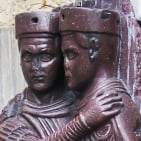Howdy, Stranger!
Categories
- All Categories
- 39 Introductions
- 3.6K Typeface Design
- 764 Font Technology
- 1K Technique and Theory
- 587 Type Business
- 435 Type Design Critiques
- 526 Type Design Software
- 30 Punchcutting
- 132 Lettering and Calligraphy
- 79 Technique and Theory
- 53 Lettering Critiques
- 461 Typography
- 289 History of Typography
- 111 Education
- 61 Resources
- 479 Announcements
- 74 Events
- 104 Job Postings
- 147 Type Releases
- 153 Miscellaneous News
- 259 About TypeDrawers
- 52 TypeDrawers Announcements
- 109 Suggestions and Bug Reports
Options
Latin small letter n with macron
 mauro sacchetto
Posts: 353
mauro sacchetto
Posts: 353
For a transliteration problem, I have to insert in a bibliography a text by Panikkar entitled:
The Vedic Experience. Veda Mantraman̄jarī.
Now, the lowercase <n> with the diacritic of macron does not exist in Unicode.
If I create the glyph, which is very fast in itself, obviously I have to create it in the PUA and the glyph lacks a unicode value.
At this point, how can I make it be recognized for example with LaTex and in any case by editors?
0
Comments
You make your glyph, leave it unencoded, and name it as a ligature of /n + /uni0304 (the combining macron): "n_uni0304". Probably you ought to have /uni0304 in the font as well.
Then set that up in 'ccmp' and you should be good, I think.
You'll either need to copy/paste the character sequence, or have a keyboard that allows you to type a combining macron (or Unicode directly). But you were going to have that sort of issue with your PUA assignment as well.
[Originally, TeX was limited to its own character set and all accented letters were defined like this. I cannot hazard a guess what happens with modern fonts. Surely it uses composite characters when available – but in your case it cannot, because there is no Unicode codepoint to use. However, OpenType support has been successfully incorporated years ago. No way to tell without trying; it might not be a problem after all.]
That said, Thomas' solution should work for all other word processors, even if it does not understand OpenType ligatures. In that case, the combining macron will be placed above the preceding character like any other combining accent – not nicely, but still understandably.
I take this opportunity to thank the members of this forum, their availability and competition. I'm learning a lot about fonts from them!
Modern orthography is मन्त्र मंजरी, I think. I've not found any other reasonable variations on that spelling. The romanised mantramañjarī as one word seems to be unique to the title of this book.
Unfortunately I don't know anything about Indian, so I can't personally evaluate the reliability of the transliteration. No publisher requires me one solution or another: I'm just trying to adopt the most correct one.
Over the i, I must confess that the line looks a bit too long to my taste indeed but I am no sanskritist.